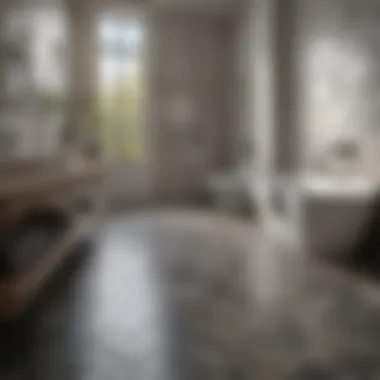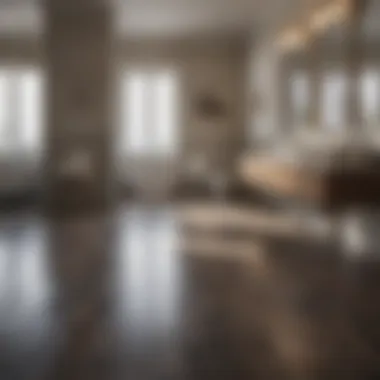Comprehensive Guide to Safety Flooring for Bathrooms


Intro
Safety flooring in bathrooms is an essential topic that deserves attention. Bathrooms are often wet environments where slips and falls can easily occur. According to statistics, a significant number of household accidents happen in these spaces. Therefore, it becomes crucial to select materials that address safety without compromising on aesthetics.
This guide explores various aspects of safety flooring specifically for bathrooms. It looks into different types of materials, their unique characteristics, and how they can enhance both safety and design. Furthermore, it discusses the implications of age-related considerations and necessary maintenance to ensure longevity and performance of the flooring.
The goal is simple: to equip homeowners and interior designers with the knowledge needed to make informed choices about safety flooring.
Trending Styles
When considering safety flooring for bathrooms, style should complement functionality. Here are two popular styles:
Modern Minimalism
Modern minimalism focuses on clean lines and simplicity. It encourages an uncluttered space, and this translates well into safety flooring choices. Materials like large-format tiles and polished concrete not only provide a sleek appearance but also offer slip-resistant options. Features like matte finishes can enhance safety by adding grip while adhering to minimalistic aesthetics.
Cozy Rustic
On the other hand, the cozy rustic style brings warmth into the bathroom. Wooden-like vinyl or laminate flooring can create that inviting feel while ensuring safety. While real wood may not be the best choice due to its susceptibility to moisture, high-quality vinyl mimics its appearance beautifully without negative impacts on performance.
Color Palettes
Color plays a significant role in designing a safe and inviting bathroom context. Choosing the right palette can enhance the aesthetics of safety flooring.
Calming Neutrals
Neutral colors instill a sense of tranquility, making them ideal for bathrooms. Shades of beige, grey, and whites can bring a calming influence. Safety flooring in these tones can blend well with various decor styles, making the space feel cohesive and spacious.
Bold Accents
In contrast, bold accent colors can create focal points. Darker colors can define areas and give a modern twist to the bathroom. However, it is crucial to combine these with lighter elements to avoid overwhelming the space. Using different textures in safety flooring can also contribute to visual interest while maintaining safety standards.
"Choosing the right safety flooring not only improves usability but also enhances the overall bathroom aesthetic."
Prolusion to Safety Flooring
In today’s home design, safety flooring in bathrooms serves a critical role. With moisture often present, slipping hazards increase significantly, making the choice of flooring an essential factor in bathroom safety. While aesthetics may draw attention, it is the practical aspects that should guide decisions. Effective safety flooring not only looks good but also minimizes the risk of accidents.
Importance of Safety in Bathroom Design
Safety in bathroom design cannot be overstated. Bathrooms are high-traffic areas where both children and elderly individuals spend considerable time. Research indicates that slips and falls are among the leading causes of injuries in these spaces. Implementing suitable safety flooring can greatly reduce the likelihood of such incidents.
When planning a bathroom, consider the following benefits of emphasizing safety:
- Injury Prevention: Quality safety flooring features slip-resistant surfaces that are crucial for wet environments.
- Peace of Mind: Knowing that the flooring minimizes risk can provide a sense of security for families.
- Increased Home Value: Homes equipped with thoughtful safety features tend to attract buyers concerned with safety.
Defining Safety Flooring
Safety flooring refers to surface materials that provide traction, comfort, and durability, specifically designed to minimize slipping risks, especially in moist environments like bathrooms. These materials can be comprised of various elements such as vinyl, rubber, cork, or tiles, each offering unique advantages.
A few key characteristics define effective safety flooring:
- Slip Resistance: Measured by the coefficient of friction, a higher rating indicates better grip.
- Durability: The ability to withstand wear and tear is essential for high-traffic areas.
- Comfort: Some materials can offer cushioning underfoot, making standing for longer periods more comfortable.
In summary, defining safety flooring involves analyzing not just its appearance but how well it performs under wet conditions. By focusing on these fundamental qualities, homeowners can create spaces that combine both elegance and functionality.
Types of Safety Flooring Materials
Safety flooring materials play a critical role in enhancing the safety and functionality of bathroom spaces. Selecting the right material is essential not only for preventing slips and falls but also for determining the overall aesthetic of the bathroom. Each type of flooring presents unique characteristics, making it suitable for various bathroom designs and user needs. Here is a closer examination of several types of safety flooring materials:


Vinyl Safety Flooring
Vinyl safety flooring is a popular choice in modern bathrooms due to its versatility. Offering a range of designs and colors, this material can easily imitate wood, stone, or intricate patterns. Its primary advantage lies in its slip resistance. Many manufacturers produce vinyl flooring that meets specific safety standards, making it a wise option.
Additionally, vinyl is relatively easy to maintain. Regular sweeping and occasional mopping with suitable cleaning agents keep the surface clean without degrading its properties. It is also water-resistant, which is particularly important in bathrooms where moisture can lead to damage. Furthermore, its affordability compared to other materials makes it an attractive choice for cost-conscious homeowners.
Rubber Flooring
Rubber flooring offers excellent slip resistance, which is essential in maintaining safety in wet environments. It is a favored choice in commercial spaces, but its benefits easily translate to residential bathrooms as well. Rubber flooring comes in various colors and textures, allowing homeowners to match their aesthetic preferences while ensuring safety.
Another advantage is its sound-absorbing qualities, which can create a quieter atmosphere in busy households. The cushioned nature of rubber also provides comfort underfoot, a significant benefit when standing for longer periods. Its resilience against wear and tear makes it ideal for high-traffic areas, ensuring long-term use without compromising safety.
Cork Flooring
Cork flooring is another option that is gaining popularity in bathroom settings. This eco-friendly material originates from the bark of cork oak trees and offers natural insulation properties. Cork is inherently resistant to mold and mildew, making it suitable for humid bathroom environments.
In terms of safety, cork has some level of slip resistance, though it may not be as effective as rubber or vinyl. Its slight cushioning can provide comfort, reducing fatigue for users standing for extended times. Homeowners who value sustainability and a warmer touch underfoot may find cork flooring appealing. Regular maintenance includes sealing the surface to prevent moisture intrusion and to preserve its natural beauty.
Porcelain and Ceramic Tiles
Porcelain and ceramic tiles have long been favored in bathrooms for their durability and water resistance. When selecting tiles, it is crucial to choose those with appropriate slip resistance ratings. Textured tiles offer better grip than smooth ones, hence enhancing safety.
Tiles are inherently low-maintenance; they can be easily cleaned with water and basic cleaning solutions. However, grout lines can trap dirt and require regular upkeep to maintain their appearance. Porcelain tiles tend to be denser than ceramic, providing enhanced resistance to moisture and staining, making them an excellent choice for increasingly wet areas.
In summary, selecting the right flooring material for a bathroom requires an understanding of various options available. Each material has its distinct qualities, providing benefits such as slip resistance, comfort, and aesthetic appeal. The importance of choosing durable and safe flooring cannot be overlooked, as it significantly contributes to a safer home environment, especially in bathrooms.
Evaluating Safety Features of Flooring
In the context of bathroom safety flooring, evaluating distinct safety features is paramount. It allows homeowners to identify which materials are suitable for their unique needs. Bathrooms can be a hazardous environment, with water often causing slips and falls. Proper evaluation of safety features enables the selection of flooring that mitigates these risks effectively.
Several key elements must be assessed, including slip resistance, impact absorption, and comfort. Each of these features contributes not only to individual safety but also enhances the overall user experience in the bathroom space.
Slip Resistance Ratings
Slip resistance is perhaps the most critical feature of safety flooring. It is essential to understand how slip resistance is measured. The coefficient of friction (CoF) is a common metric, indicating how much traction the flooring offers when wet. Higher CoF values demonstrate better slip resistance, making floors safer under wet conditions.
When evaluating flooring options, look for materials that meet safety standards established by organizations like the American National Standards Institute (ANSI). Options such as vinyl and rubber flooring often come with good slip resistance ratings, making them excellent choices for bathrooms. Some manufacturers provide detailed slip resistance ratings and certifications that assure consumers about the material's safety performance.
"Choosing flooring with the proper slip resistance can significantly reduce the risk of accidents in the bathroom."
Impact Absorption
Impact absorption is another important characteristic of bathroom flooring. This feature measures how well a surface can absorb shock from falls. When selecting flooring, consider materials that provide adequate cushioning to reduce the likelihood of injury when falls occur.
Rubber flooring excels in this regard. Its ability to absorb impact effectively makes it a preferred option in spaces frequented by children or elderly individuals. The softer surface reduces pressure on joints during daily use, adding an essential layer of comfort.
Evaluating the impact absorption qualities of flooring can be vital to maintaining safety, especially in homes with children or older adults. Such considerations are important for creating a secure environment.
Comfort and Heat Insulation
Lastly, comfort is often an overlooked feature in the evaluation process of bathroom flooring. The right material should provide comfort underfoot, especially since bathrooms can experience fluctuations in temperature. Comfortable flooring can enhance the daily user experience.
Heat insulation is also significant, particularly in chilly climates. Some materials, like cork, provide a natural barrier against cold, ensuring comfort when stepping onto the floor. Additionally, selecting flooring that retains warmth can save energy costs.
In summary, evaluating safety features of flooring involves a holistic approach, integrating slip resistance, impact absorption, and comfort into the decision-making process. Making informed decisions can enhance the safety and usability of bathroom spaces.
Installation Considerations
When it comes to safety flooring in bathrooms, the installation phase is crucial. Proper installation ensures not only the effectiveness of the flooring in preventing slips and falls but also its longevity and ease of maintenance. This section delves into the specific elements that must be considered during installation to achieve the best outcomes.


Professional vs. DIY Installation
Homeowners often face the decision of whether to hire professionals or to undertake the installation themselves. Each approach has its own advantages and disadvantages.
Professional installation offers expertise that can be invaluable. Professionals are knowledgeable about different types of flooring and can ensure that all local building codes are met. They have the proper tools and experience for handling complex installations. This often results in fewer mistakes, saving time and money in the long run.
On the other hand, DIY installation can be appealing for those looking to save costs. With resources available online, it is possible for homeowners to learn how to install safety flooring themselves. However, this route may involve a steep learning curve and the risk of improper installation, which may lead to issues like uneven surfaces or inadequate sealing.
Subfloor Requirements
The condition of the subfloor is another critical aspect of installation that can influence the success of safety flooring. A suitable subfloor is essential for achieving stability and durability. Before installing any type of safety flooring, inspect the subfloor for damage, moisture, or unevenness.
- Concrete should be dry and solid, with no visible cracks. A moisture barrier may be needed.
- Plywood surfaces should be smooth and level. Any loose or damaged areas must be repaired.
- Tile subfloors must be intact, without cracked tiles that could lead to further complications.
In some cases, additional underlayment may be advisable to improve comfort and insulation.
Sealing and Edging Options
Sealing and edging are significant considerations that affect the performance and aesthetics of safety flooring. Properly sealed edges prevent moisture ingress, which is especially important in bathrooms where water exposure is frequent.
Sealing methods vary depending on the type of flooring:
- Vinyl flooring often comes with built-in sealers, but additional sealing may be recommended to enhance water resistance.
- Rubber flooring should be sealed to prevent delamination over time.
- Tile installations typically require grout sealing to safeguard against staining and moisture damage.
Edging options also play a role in both safety and appearance. Transition strips may be necessary to create a smooth transition between different flooring types, reducing tripping hazards. It's essential to select edging that complements the design while maintaining functionality.
Proper installation, along with attention to subfloor and sealing, leads to enhanced performance and longevity of safety flooring.
These considerations ensure that safety flooring fulfills its purpose effectively—providing both a safe and stylish bathroom environment.
Aesthetic Considerations in Safety Flooring
When selecting safety flooring for bathrooms, aesthetics play a crucial role in overall design. While safety features are paramount, the visual aspect of flooring cannot be ignored. Homeowners should be mindful of how the flooring complements or enhances the space. Here, we examine important elements, benefits, and considerations related to the aesthetic aspect of safety flooring.
Color and Design Choices
Color selection in safety flooring impacts the ambiance and mood of the bathroom. Various colors can evoke different feelings and set the tone for the space. For instance, soft blues and light greens can create a calming atmosphere, while brighter colors may energize it.
Design choices, too, are essential. Textured finishes can add depth and style. Manufacturers offer an array of patterns that mimic natural materials, such as wood or stone, thus allowing homeowners to adhere to a specific theme or personal taste. Moreover, these design elements can provide visual interest that may draw attention away from purely functional aspects.
Matching with Bathroom Decor
It is vital to ensure that the chosen safety flooring aligns with existing bathroom decor. Flooring creates a foundation for the overall design. When there is harmony between flooring and other elements, such as fixtures, cabinetry, and wall colors, it leads to a cohesive look.
Choosing flooring that enhances or complements the bathroom style is advisable. For contemporary designs, sleek and minimalistic options like large format tiles may work best. In contrast, for traditional setups, classic patterns or warmer tones can provide a pleasing effect.
Taking time to assess lighting in the bathroom is also essential. Natural light and artificial sources can change how the color of the flooring appears. Therefore, it is wise to test samples under different lighting conditions before making a final decision.
In summary, the aesthetic aspects of safety flooring in bathrooms are just as important as the safety features themselves. Incorporating thoughtful color and design choices can elevate the space, making it not only safe but also visually appealing.
Maintenance and Care
Maintaining the safety of flooring in bathrooms is essential for long-lasting functionality and aesthetics. Proper care can help extend the life of the flooring materials while ensuring that they remain slip-resistant and visually appealing. Regular maintenance is necessary to prevent accidents and enhance the beauty of the bathroom. Attention to cleaning practices and preventive measures can significantly mitigate wear and damage.
Cleaning Practices
The cleaning of safety flooring is a vital aspect of maintenance that influences both safety and hygiene. Different flooring materials require specific cleaning methods to keep them in optimum condition. For instance, vinyl safety flooring often requires sweeping or vacuuming to remove dirt and debris followed by mopping with a pH-neutral cleaner. Rubber flooring can be wiped down with warm soapy water, which makes it simple to keep clean without much effort.
It's recommendable to avoid harsh chemicals or abrasive tools that may damage the finish or the texture of the flooring. Regular cleaning at least once a week can help maintain its slip resistance. Not only does this protect your investment but it also assures a safer bathroom environment.


Preventing Damage and Wear
Preventive measures play a significant role in safeguarding safety flooring against premature wear and damage. Understanding the characteristics of the flooring material assists in using it properly. For example, placing mats in areas prone to water exposure can absorb excess moisture, reducing the risk of water damage and slip hazards.
Furthermore, using furniture pads under heavy items can prevent scratching and dents on the surface. Avoiding heavy impact on the flooring is also essential; thus, managing traffic flow and ensuring gentle handling of objects will help tremendously. Regular inspections should be part of routine maintenance to identify any wear early on.
Maintaining safety flooring not only protects against slips but also enhances the overall appearance of your bathroom.
In summary, it is crucial to emphasize the significance of regular cleaning practices and preventive techniques to maintain safety flooring effectively. By establishing these routines, homeowners can enhance longevity and ensure that their bathrooms remain safe and functional.
Age-Related Considerations
Age-related considerations play a significant role in the selection of safety flooring for bathrooms. These spaces must not only be aesthetically pleasing but also functional for all age groups. When discussing bathromm safety, it is crucial to recognize that both elderly individuals and children have specific needs that necessitate a focused approach to flooring design.
Designing for Elderly Users
When designing a bathroom for elderly users, it is important to prioritize fall prevention. Falls are among the leading causes of injury in older adults. Choosing the right flooring becomes a key factor in enhancing safety.
- Slip Resistance: Floor materials should have high slip resistance. This minimizes the risk of falls, particularly when the floor is wet. Products labeled with a high coefficient of friction are preferred.
- Smooth Transitions: Installing flooring with smooth transitions can prevent tripping. Avoid thresholds that create height differences, as these can be hazardous.
- Texture and Comfort: Textured surfaces help with grip but should remain comfortable. Sensitive feet should not be subjected to rough or unforgiving surfaces.
- Height Considerations: When planning the space, ensure that fixtures like toilets and sinks can accommodate users comfortably. Safety flooring should be designed to integrate with these elements to minimize barriers.
Children and Safety Flooring
Children also present unique demands when it comes to safe flooring choices in the bathroom. Their natural tendency towards play can lead to unintentional accidents, making flooring selection crucial.
- Durability: Flooring must withstand wear and tear due to active play. For example, vinyl and rubber options are often recommended for their ability to absorb impacts.
- Softness and Cushioning: Opt for softer flooring to lessen injury risks during falls. Materials like cork or rubber offer cushioning which can be beneficial.
- Ease of Cleaning: Messes are inevitable with children. A floor that is easy to clean helps maintain hygiene while making it less of a chore for parents.
Choosing appropriate safety flooring helps create a secure environment for children, significantly lowering the chances of accidents.
- Color and Design: Bright colors or fun patterns can engage children while also serving as a visual alert for areas that may be slippery.
In summary, age-related considerations in bathroom design are essential for creating a safe environment. Whether addressing the needs of elderly users or children, careful selection of safety flooring can drastically reduce risk while enhancing functionality and comfort.
Cost Considerations
When planning for safety flooring in bathrooms, understanding cost considerations is vital. The financial aspect can significantly influence design choices and material selection, impacting both functionality and aesthetics. Safety flooring's role in preventing accidents enhances its value, but the initial outlay can be a barrier if not carefully planned. Proper budgeting ensures that homeowners can select suitable options without compromising safety or style.
Budgeting for Safety Flooring
Creating a budget is an important step when considering safety flooring. It helps homeowners to manage expectations regarding the total expense associated with materials, labor, and potential maintenance. Here are a few key points to keep in mind:
- Material Cost: Different types of safety flooring materials come with varying price tags. Vinyl, for instance, might be more cost-effective compared to high-end rubber flooring.
- Installation Expenses: Professional installation can increase the overall cost. It is essential to weigh the pros and cons of hiring a contractor versus a DIY approach.
- Maintenance and Longevity: Some flooring options require more upkeep or replacement sooner, adding hidden costs over time.
Establishing an accurate budget not only involves immediate expenses but also considers future requirements as your bathroom might need updates.
Long-Term Value vs. Initial Costs
Investing in safety flooring goes beyond the upfront costs. It's crucial to evaluate long-term value alongside initial expenses. Quality materials may seem expensive initially but tend to offer better durability and efficiency over time. Assess the following aspects:
- Durability: High-quality flooring is less likely to wear down or require replacements within short periods, which could save money in the long run.
- Health and Safety: A well-chosen safety flooring can reduce accidents, potentially saving costs related to injuries or insurance.
- Aesthetic Value: Durable and attractive flooring can increase the property's value over time, making it a wise investment.
By understanding both short-term and long-term financial implications, homeowners can make informed decisions about safety flooring that align with their overall goals.
Ending
In a world where safety often takes a backseat to aesthetics, the importance of safety flooring in bathrooms cannot be overstated. This conclusion aims to pull together the critical elements discussed throughout the guide. First, understanding the types of safety flooring materials available is crucial. Vinyl safety flooring, rubber flooring, cork flooring, and ceramic tiles all offer unique benefits suited for different household needs.
Summarizing Key Points
Each type of material provides various safety features, including slip-resistance ratings and impact absorption. When selecting flooring, it is essential not only to consider durability and comfort but also to prioritize ease of maintenance. Homeowners should be well-informed about installation options, whether to choose professional help or take on the challenge themselves. The balance between maintaining safety and adhering to personal aesthetic preferences is delicate but achievable.
"Investing in safety flooring is an investment in well-being and peace of mind."
Future Trends in Bathroom Safety Flooring
Looking at the future of bathroom safety flooring, we notice several trends on the horizon. Eco-friendly materials are gaining popularity as more homeowners prioritize sustainability. Innovations in design are also emerging, where functionality meets style. Additionally, advancements in slip-resistance technology are expected to enhance the safety features of flooring options available in the market. As bathrooms continue to be areas of relaxation and rejuvenation, ensuring they remain safe through quality flooring is likely to remain a priority for consumers.
The guide has addressed numerous aspects of safety flooring in bathrooms, illustrating how crucial informed decisions can be in preventing accidents and enhancing comfort.















